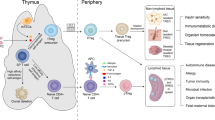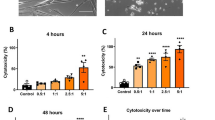Abstract
The innate and adaptive immune responses contribute to the development of inflammatory myopathies; the innate immune system does so through activation of the type I interferon and Toll-like receptor pathways. Dendritic cells have a pivotal role in the development of both adaptive and innate immune responses. Equipped with a range of pattern-recognition receptors, dendritic cells link innate and adaptive immunity. This Perspectives article discusses novel concepts in myositis, focusing on immature muscle precursors. Of interest, the immature muscle precursors involved in regeneration are associated with upregulation of HLA class I antigens and myositis-associated autoantigens, as well as activation of the Toll-like receptor pathway and production of type I interferon, and could have a critical contribution to the pathogenesis of myositis. These regenerating immature muscle cells might also be a target of the immune response in myositis, thereby explaining why muscle regeneration is not effective in the context of such inflammation.
This is a preview of subscription content, access via your institution
Access options
Subscribe to this journal
Receive 12 print issues and online access
$209.00 per year
only $17.42 per issue
Buy this article
- Purchase on Springer Link
- Instant access to full article PDF
Prices may be subject to local taxes which are calculated during checkout

Similar content being viewed by others
References
Sordet, C., Goetz, J. & Sibilia, J. Contribution of autoantibodies to the diagnosis and nosology of inflammatory muscle disease. Joint Bone Spine 73, 646–654 (2006).
Miller, F. W., Twitty, S. A., Biswas, T. & Plotz, P. H. Origin and regulation of a disease-specific autoantibody response. Antigenic epitopes, spectrotype stability, and isotype restriction of anti-Jo-1 autoantibodies. J. Clin. Invest. 85, 468–475 (1990).
Stone, K. B. et al. Anti-Jo-1 antibody levels correlate with disease activity in idiopathic inflammatory myopathy. Arthritis Rheum. 56, 3125–3131 (2007).
Casciola-Rosen, L. et al. Enhanced autoantigen expression in regenerating muscle cells in idiopathic inflammatory myopathy. J. Exp. Med. 201, 591–601 (2005).
Levine, S. M. et al. Novel conformation of histidyl-transfer RNA synthetase in the lung: the target tissue in Jo-1 autoantibody-associated myositis. Arthritis Rheum. 56, 2729–2739 (2007).
Howard, O. M. et al. Histidyl-tRNA synthetase and asparaginyl-tRNA synthetase, autoantigens in myositis, activate chemokine receptors on T lymphocytes and immature dendritic cells. J. Exp. Med. 196, 781–791 (2002).
Eloranta, M. L. et al. A possible mechanism for endogenous activation of the type I interferon system in myositis patients with anti-Jo-1 or anti-Ro 52/anti-Ro 60 autoantibodies. Arthritis Rheum. 56, 3112–3124 (2007).
Hohlfeld, R. & Engel, A. G. Coculture with autologous myotubes of cytotoxic T cells isolated from muscle in inflammatory myopathies. Ann. Neurol. 29, 498–507 (1991).
Bender, A. et al. T cell receptor repertoire in polymyositis: clonal expansion of autoaggressive CD8+ T cells. J. Exp. Med. 181, 1863–1868 (1995).
Benveniste, O. et al. Severe perturbations of the blood T cell repertoire in polymyositis, but not dermatomyositis patients. J. Immunol. 167, 3521–3529 (2001).
Zong, M. et al. Effects of immunosuppressive treatment on interleukin-15 and interleukin-15 receptor α expression in muscle tissue of patients with polymyositis and dermatomyositis. Ann. Rheum. Dis. 71, 1055–1063 (2012).
Tournadre, A. et al. TH1 and TH17 balance in inflammatory myopathies: interaction with dendritic cells and possible link with response to high-dose immunoglobulins. Cytokine 46, 297–301 (2009).
Lundberg, I., Brengman, J. M. & Engel, A. G. Analysis of cytokine expression in muscle in inflammatory myopathies, Duchenne dystrophy, and non-weak controls. J. Neuroimmunol. 63, 9–16 (1995).
Lepidi, H. et al. Local expression of cytokines in idiopathic inflammatory myopathies. Neuropatho. Appl. Neurobiol. 24, 73–79 (1998).
Tucci, M., Quatraro, C., Dammacco, F. & Silvestris, F. Interleukin-18 overexpression as a hallmark of the activity of autoimmune inflammatory myopathies. Clin. Exp. Immunol. 146, 21–31 (2006).
Miossec, P., Korn, T. & Kuchroo, V. K. Interleukin-17 and type 17 helper T cells. N. Engl. J. Med. 361, 888–898 (2009).
Chevrel, G. et al. Interleukin-17 increases the effects of IL-1β on muscle cells: arguments for the role of T cells in the pathogenesis of myositis. J. Neuroimmunol. 137, 125–133 (2003).
Page, G., Chevrel, G. & Miossec, P. Anatomic localization of immature and mature dendritic cell subsets in dermatomyositis and polymyositis: interaction with chemokines and TH1 cytokine-producing cells. Arthritis Rheum. 50, 199–208 (2004).
Tournadre, A. & Miossec P. Cytokine response in inflammatory myopathies. Curr. Rheumatol. Rep. 9, 286–290 (2007).
Tournadre, A. & Miossec P. Chemokines and dendritic cells in inflammatory myopathies. Ann. Rheum. Dis. 68, 300–304 (2009).
Chevrel, G., Granet, C. & Miossec, P. Contribution of tumour necrosis factor α and interleukin (IL) 1β to IL6 production, NF-κB nuclear translocation, and class I MHC expression in muscle cells: in vitro regulation with specific cytokine inhibitors. Ann. Rheum. Dis. 64, 1257–1262 (2005).
Li, Y. & Reid, M. B. Effect of tumor necrosis factor-α on skeletal muscle metabolism. Curr. Opin. Rheumatol. 13, 483–487 (2001).
Austin, L. & Burgess, A. W. Stimulation of myoblast proliferation in culture by leukaemia inhibitory factor and other cytokines. J. Neurol. Sci. 101, 193–197 (1991).
Austin, L., Bower, J., Kurek, J. & Vakakis, N. Effects of leukaemia inhibitory factor and other cytokines on murine and human myoblast proliferation. J. Neurol. Sci. 112, 185–191 (1992).
Dastmalchi, M. et al. A high incidence of disease flares in an open pilot study of infliximab in patients with refractory inflammatory myopathies. Ann. Rheum. Dis. 67, 1670–1677 (2008).
Walsh, R. J. et al. Type I interferon-inducible gene expression in blood is present and reflects disease activity in dermatomyositis and polymyositis. Arthritis Rheum. 56, 3784–3792 (2007).
Baechler, E. C. et al. An interferon signature in the peripheral blood of dermatomyositis patients is associated with disease activity. Mol. Med. 13, 59–68 (2007).
Greenberg, S. A. et al. Interferon-α/β-mediated innate immune mechanisms in dermatomyositis. Ann. Neurol. 57, 664–678 (2005).
Cappelletti, C. B. F. et al. Type I interferon and Toll-like receptor expression characterizes inflammatory myopathies. Neurology 76, 2079–2088 (2011).
Tournadre, A., Lenief, V., Eljaafari, A. & Miossec, P. Immature muscle precursors are a source of interferon-β in myositis: role of Toll-like receptor 3 activation and contribution to HLA class I up-regulation. Arthritis Rheum. 64, 533–541 (2012).
Leadbetter, E. A. et al. Chromatin–IgG complexes activate B cells by dual engagement of IgM and Toll-like receptors. Nature 416, 603–607 (2002).
Lau, C. M. et al. RNA-associated autoantigens activate B cells by combined B cell antigen receptor/Toll-like receptor 7 engagement. J. Exp. Med. 202, 1171–1177 (2005).
Tournadre, A., Lenief, V. & Miossec, P. Expression of Toll-like receptor 3 and Toll-like receptor 7 in muscle is characteristic of inflammatory myopathy and is differentially regulated by TH1 and TH17 cytokines. Arthritis Rheum. 62, 2144–2151 (2010).
Schreiner, B. et al. Expression of Toll-like receptors by human muscle cells in vitro and in vivo: TLR3 is highly expressed in inflammatory and HIV myopathies, mediates IL-8 release and up-regulation of NKG2D-ligands. FASEB J. 20, 118–120 (2006).
Bell, D., Young, J. W. & Banchereau, J. Dendritic cells. Adv. Immunol. J. 72, 255–324 (1999).
Lopez de Padilla, C. M. et al. Plasmacytoid dendritic cells in inflamed muscle of patients with juvenile dermatomyositis. Arthritis Rheum. 56, 1658–1668 (2007).
Greenberg, S. A., Pinkus, G. S., Amato, A. A. & Pinkus, J. L. Myeloid dendritic cells in inclusion-body myositis and polymyositis. Muscle Nerve 35, 17–23 (2007).
Emslie-Smith, A. M., Arahata, K. & Engel, A. G. Major histocompatibility complex class I antigen expression, immunolocalization of interferon subtypes, and T cell-mediated cytotoxicity in myopathies. Hum. Pathol. 20, 224–231 (1989).
Nagaraju, K. et al. Conditional up-regulation of MHC class I in skeletal muscle leads to self-sustaining autoimmune myositis and myositis-specific autoantibodies. Proc. Natl Acad. Sci. USA 97, 9209–9214 (2000).
Nagaraju, K. et al. Activation of the endoplasmic reticulum stress response in autoimmune myositis: potential role in muscle fiber damage and dysfunction. Arthritis Rheum. 52, 1824–1835 (2005).
Author information
Authors and Affiliations
Contributions
A. Tournadre and P. Miossec researched data for the article, discussed its content, and wrote the manuscript. P. Miossec also reviewed and edited the manuscript before submission.
Corresponding author
Ethics declarations
Competing interests
The authors declare no competing financial interests.
Rights and permissions
About this article
Cite this article
Tournadre, A., Miossec, P. A critical role for immature muscle precursors in myositis. Nat Rev Rheumatol 9, 438–442 (2013). https://doi.org/10.1038/nrrheum.2013.26
Published:
Issue Date:
DOI: https://doi.org/10.1038/nrrheum.2013.26
This article is cited by
-
Dermatomyositis: immunological landscape, biomarkers, and potential candidate drugs
Clinical Rheumatology (2021)
-
Inflammatory predisposition predicts disease phenotypes in muscular dystrophy
Inflammation and Regeneration (2016)
-
Cell death, clearance and immunity in the skeletal muscle
Cell Death & Differentiation (2016)



